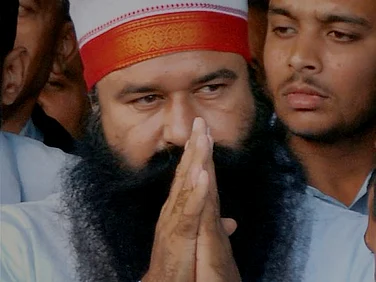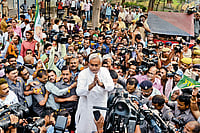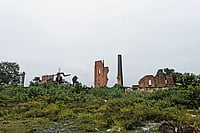“The bulldozer and not the atomic bomb may turn out to be the most destructive invention of the 20th century.”
—Philip Shabecoff, author and environment journalist
The bulldozer, a giant, motorised machine that looks and behaves like a marauding dinosaur, has now become the latest tool to polarise the electorate, divide society on communal lines and present a masculine image of the government. And the term ‘bulldozer justice’ has emerged as the new keyword after homes and shops of people accused of violence and other crimes were razed by bulldozers in Uttar Pradesh, Madhya Pradesh, Delhi and Haryana. What have gone under the radar are similar acts of bulldozing being carried out in Bihar, especially in the capital city of Patna. Bulldozers are ramming through the vibrant and rich architectural heritage of the city, which was at the centre of international trade during the 17th century. And the people have remained largely silent—some out of ignorance, most due to apathy.
ALSO READ: Tentacles Of Power
Over the past three decades, more than a dozen heritage structures like the Dak Bungalow, Bankipore Central Jail, Civil Surgeon’s Bungalow, Anjuman Islamia Hall, Gole Market, the British-era new police lines and parts of Patna Medical College and Hospital (PMCH) have been demolished to make way for new concrete buildings without the style and character of the old ones. One of the first to go was the Coffee House near the Dak Bungalow crossing, one of Patna’s most iconic structures which was once the favourite meeting place of prominent people, including writers Phanishwar Nath Renu and Ramdhari Singh Dinkar, besides many political leaders.
Over the years, flyovers, roads, new government buildings, shopping malls and highrise apartment complexes replaced these heritage buildings. Some other heritage buildings will be bulldozed in a few years. A proposed double-decker flyover on Ashok Rajpath will be coming up at the cost of heritage structures, including part of the Khuda Bakhsh Oriental Public Library, which was built in the 19th century. The Ganga riverfront in Patna, which has a rich history and natural beauty, is witnessing concretisation as part of a beautification plan—the new Loknayak Ganga path, a 21.6 km-long expressway along the riverbank. In a report on the impact of the project, the People’s Resource Centre says, “It is poised to cause severe harm to the local ecology and bring changes in the regional hydrological cycles and thus ultimately affect communities dependent on various riverine and common resources.”

The Dutch-era collectorate building, now the revenue and archive office, is another heritage structure which will be demolished to make way for a new collectorate. A tin board on the boundary wall of the building reads, “Site for construction of new collectorate.” Outside the collectorate premises, the outer wall provides shade for petty traders and those with time to kill. An elderly man, munching bhunja as he sits on a chowki, throws in his bit about the proposed demolition. “Supreme Court me mamla gaya hai. Supreme Court ka kahna hai ki ye purana dharohar hai…isko bachaya jaye. Jadughar purana hi hai lekin chamak raha hai. Isko bhi waise chamkana chahiye na ki tod dena chahiye. (The case is in the Supreme Court which has said that this building is heritage and should be protected. The Patna Museum is also very old but it is shining. This building too should be renovated instead of being demolished).” Next to him, a barber applying black henna to a customer’s white hair, also joins the debate. “25 inch ka dewal hai iska. Pankha chalta hai to ac jaisa thanda rahta hai kamra. Abhi koi aisa bana payega? (The walls of this building are 25 inches wide. When you switch on the fan, it gives the effect of an air conditioner. Who can make a such structure like this now?)”
When a campaign was launched to save the old collectorate, a government official was quoted in local media as saying that the building was used only as a warehouse during the Dutch times and hence has no heritage value. “It is unwise to say that it was a warehouse, so it has no heritage value. It has a heritage value. It reminds us that our economy was vibrant, we were an exporting economy. Silver inflows were taking place in exchange for the goods we sent out, thereby boosting our economy,” says Murari Jha, an assistant professor at Ahmedabad University, who has done research on Dutch architecture. “We must protect these structures to make them aware that we had a marvellous economy in the pre-colonial period. This way we can remind them that we still have the potential to become an exporting economy,” he says.
Though the government has put off demolition of the Old Collectorate and Khuda Bakhsh Oriental Public Library—for the time being—following protests by civil society, there is not much visible will among the people to save similar heritage buildings. Patna-born independent researcher Kunal Dutt, who is campaigning to preserve Bihar’s heritage, launched a citizen-led initiative, Save Historic Patna Collectorate, in 2016. “Making a future by consuming the past is extremely dangerous. If such demolition continues, very soon Patna will become a city which has no memory. But the irony is, the common people have no issue with this,” Dutt says. “People at least protest and raise a voice if their properties are threatened, but heritage buildings suffer in silence, and despite their strength meekly submit when bulldozed. As a conscientious society, people must become the voice of their heritage, spokespersons of their plight and champions for their preservation, and not remain criminally silent, as Patna is right now,” he adds.
Over the years, the state government has faced criticism for only paying lip service to protecting Bihar’s heritage. A Heritage Commission was announced way back in 2012 but it was constituted half-a-decade later with only government officials as members. Last year, the Patna high court had criticised the state government for constituting an imbalanced heritage panel. “It appears that the intention and will to preserve its history is lacking in the state’s executive,” the court had said. Officially, the state government has only 35 monuments worth preservation across the state though the Archaeological Survey of India considers 66 structures of Bihar as heritage. No monument in Patna is on the ASI list.
J.K. Lall, the convenor of the Patna chapter of Indian National Trust for Art and Cultural Heritage (INTACH), says, “We have knocked on the door of the Supreme Court for reconstitution of the Heritage Commission to include historians and heritage experts. An order is awaited,” he says, adding that a legislation should be passed to protect the city’s heritage. Underlining the importance of heritage, Piyush Kamal Sinha, professor of History, Magadh University, says “If any heritage structure is a hindrance in the way of development, it can be demolished, but first the government needs to develop a mechanism through which it can decide which heritage is important and why they should be protected. It is not right to demolish any historical structure arbitrarily.”
(This appeared in the print edition as "Bulldozing History")
ALSO READ



























